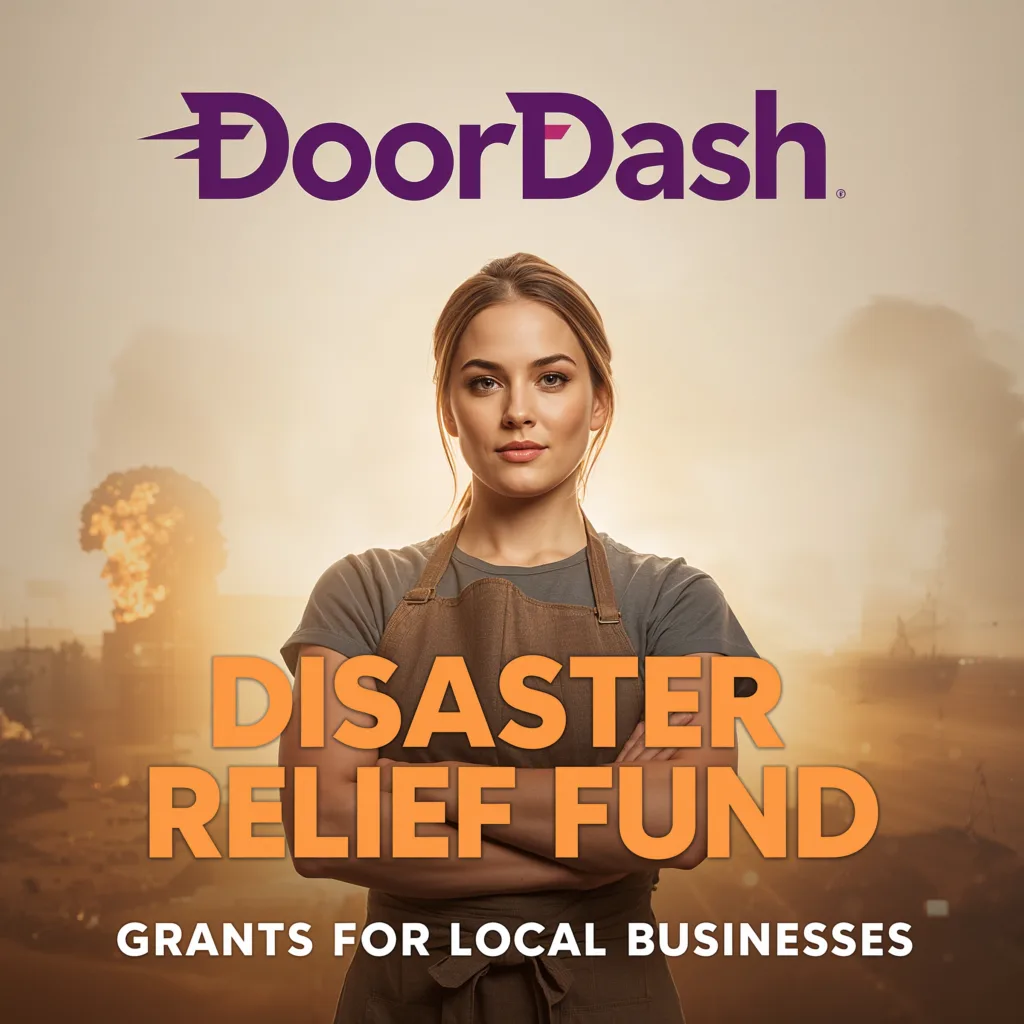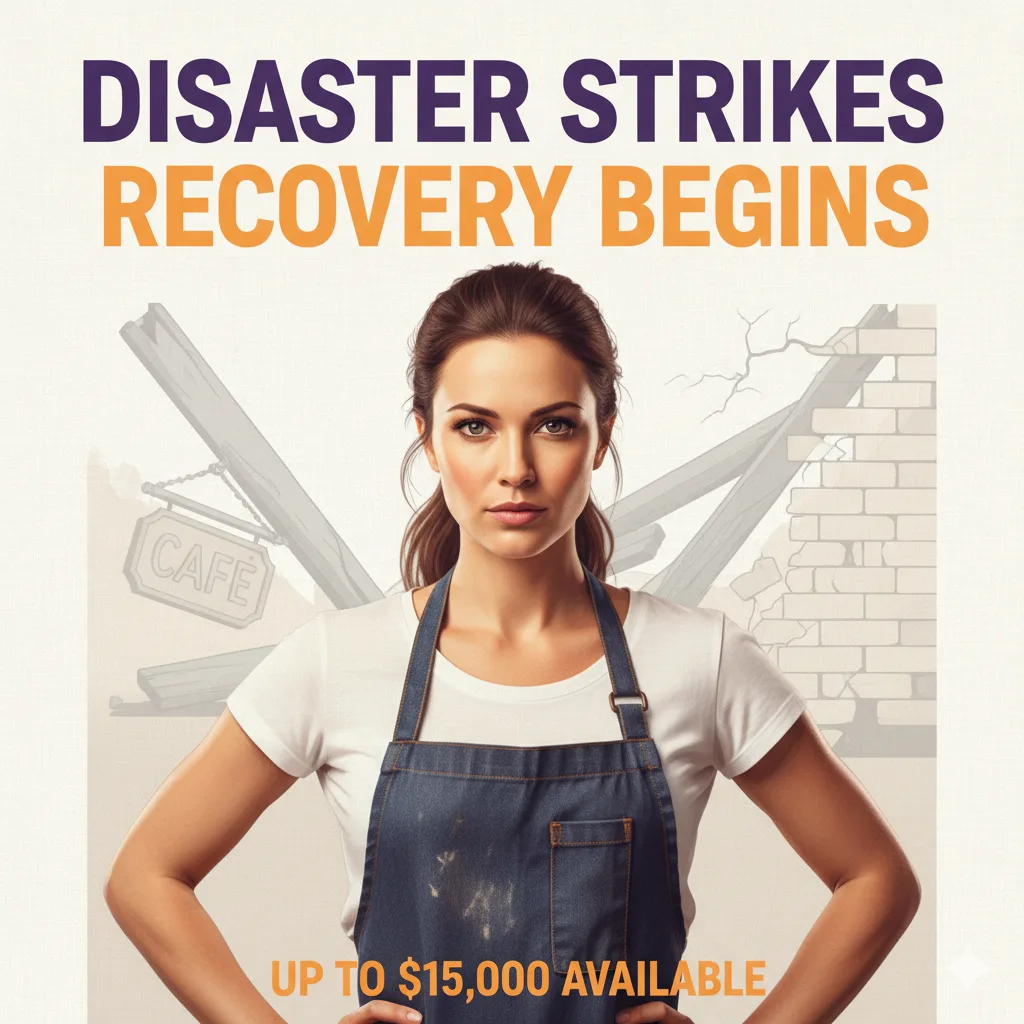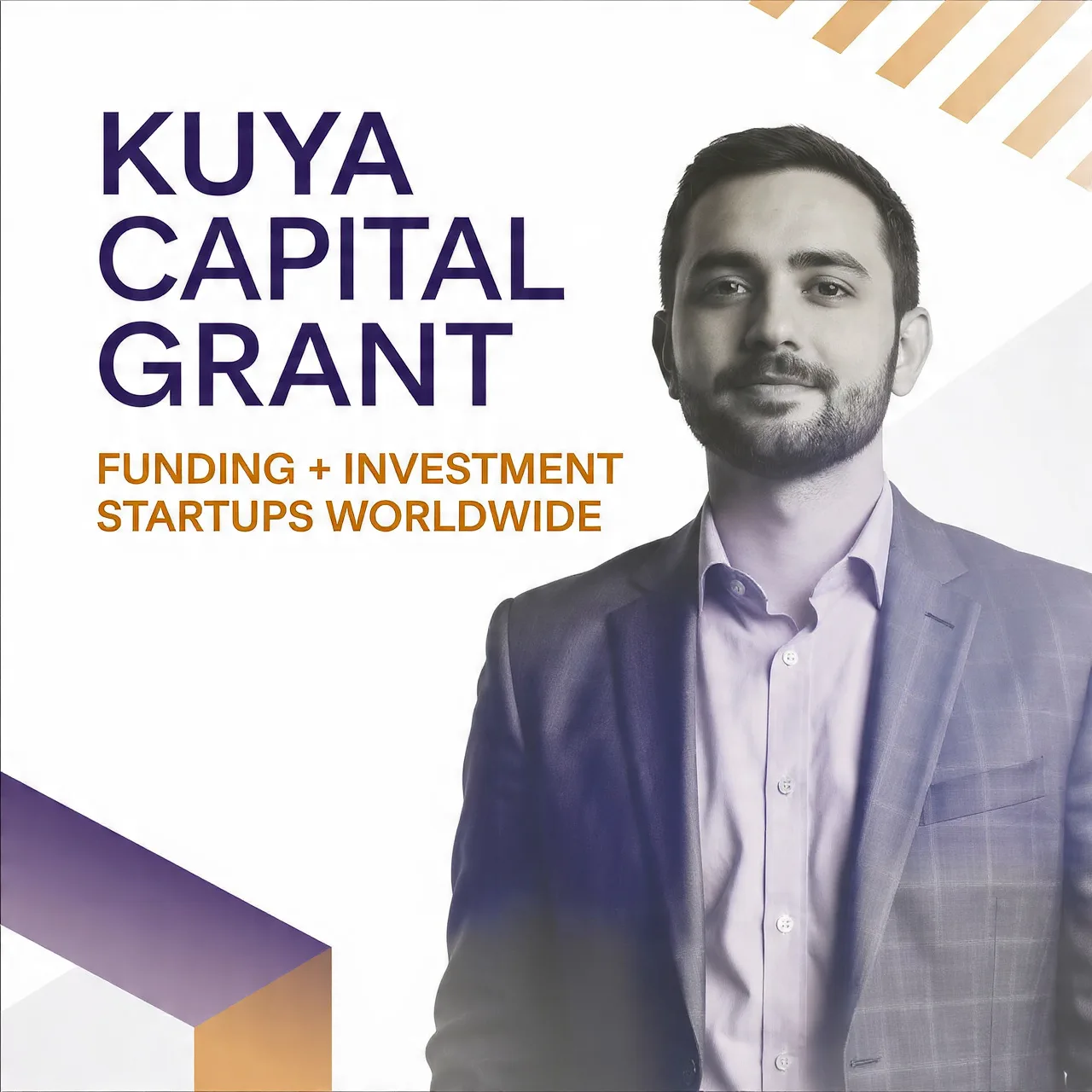
DoorDash Disaster Relief Fund: $5K – $15K Emergency Grants for Local Business Recovery After Natural Disasters
Get up to $15,000 in emergency grants for restaurants and local businesses affected by natural disasters. No repayment required.
Grant Overview
Get Emergency Funding for Your Restaurant, Local Grocery, Pet Shops, Florists, Convenience Stores, and Neighborhood Merchants When Disasters Strike across North America and Beyond
DoorDash Disaster Relief Fund is a rapid-response grant program designed to give small, local businesses short-term, no-repay financial support after declared natural disasters so they can pay rent, replace inventory, fix damaged equipment, and pay staff while they recover. Read our quick summary about the DoorDash grant on Grantaura.
The DoorDash Disaster Relief Fund offers grants ranging from $5,000 to $15,000 for local businesses including restaurants, flower shops, liquor stores, convenience stores, pet stores, and local grocers that have been impacted by natural disasters. This expanded program, originally starting as the Restaurant Disaster Relief Fund in 2021, has now evolved into something bigger and more inclusive.
Since 2021, DoorDash has funneled nearly $10 million into hundreds of businesses across the United States, Puerto Rico, and beyond, making this one of the most accessible disaster recovery options for independently-owned local businesses.
When a hurricane tears through your neighborhood or floods destroy your inventory, the last thing you need is bureaucratic red tape. This fund cuts through all that. The grants can help cover essential operation expenses such as rent, repairs for damages, mortgage payments, payroll, and other critical bills. Whether you run a small pizzeria in Puerto Rico, a flower shop in California, or a corner grocery in Kansas, if disaster has knocked you down, this could be your lifeline back. The fund isn’t just about restaurants anymore. The program has now expanded and been renamed the DoorDash Local Business Relief Fund and now includes support for grocery stores, pharmacies, florists, and other local businesses affected by disasters.
Title: DoorDash Local Business Disaster Relief Fund
Donor: DoorDash, in partnership with Hello Alice and Global Entrepreneurship Network
Focus: Natural disaster recovery, small business emergency relief, restaurant support, local business funding, severe weather assistance, infrastructure failure aid, community recovery
Region: United States, District of Columbia, Puerto Rico, Canada, Australia, New Zealand
Eligibility:
– Must be the leading executive (Founder, CEO, President, etc.) of the business
– Must be at least 18 years old (19 in AL and NE)
– Business must be a for-profit entity located and registered in one of the fifty United States, D.C., or Puerto Rico
– Business must be a restaurant, flower shop, liquor store, convenience store, pet store, or local grocery store
– Must have a brick & mortar location that has experienced a loss in revenue as a direct result of a natural disaster, severe weather event, or major infrastructure failure
– The disaster must have occurred within the last 12 months and been declared by state, tribal, or federal government
– Business must own a maximum of three locations
– Must employ fewer than 50 employees per location
– Must have been open for at least six months
– Must have revenues of $3M or less per location in 2024
– Must be independently-owned
Benefits:
– Financial Award: $5,000 to $15,000 grants depending on need and damage extent
– Rapid Distribution: Funds awarded within 60 days of application close
– Flexible Use: Can cover rent, utilities, maintenance, supplies, payroll, inventory replacement, equipment repair
– Quarterly Awards: Multiple funding opportunities throughout the year
– Community Support: Part of DoorDash’s broader commitment to local business recovery
Deadline: Ongoing – January 6, 2026 at 6 PM ET (Q4 2025 Round)

What This Fund Really Does for Your Business
Nearly 40% of small businesses never reopen after a major disaster. The ones that do often limp along for months, bleeding cash while waiting for insurance adjusters, FEMA paperwork, or SBA disaster loans to come through. The DoorDash Disaster Relief Fund was designed to sidestep that bureaucratic nightmare. It’s not replacing those other resources; it’s filling the gap while you wait for them.
Close to half of applicants from last year’s Fund said they had to close for over a month due to the disaster. That’s devastating for any small business owner watching bills pile up while their doors stay locked. But here’s what matters: 96% of surveyed grant recipients say they found the grant substantially helpful in maintaining operations after the disaster and 61% said their revenue was at the same or above pre-disaster levels three months after receiving the grant.
The fund started back in October 2021 when DoorDash realized local restaurants were getting crushed by disasters and couldn’t bounce back. Since 2021, the Fund has provided more than $1.8 million in relief grants to more than 180 local restaurants across the United States, Puerto Rico, Canada, Australia, and New Zealand. But they didn’t stop there. In 2025, DoorDash expanded the program dramatically. Now it’s not just for restaurants. Your local flower shop that got flooded? Covered. The corner convenience store hit by wildfire smoke damage? They can apply too.
Q: Can I apply if my business isn’t on DoorDash?
A: Yes, though DoorDash prioritizes small businesses that are on the DoorDash platform
Q: What counts as a disaster?
A: An eligible state or federally-declared natural disaster, including but not limited to wildfires, hurricanes, and earthquakes
Q: How long after a disaster can I apply?
A: Applications must be submitted within 12 months of the declared disaster
What Types of Disasters Qualify for Support?
The DoorDash Disaster Relief Fund covers a wide range of disruptive events, provided they’ve been officially declared by government authorities. This includes hurricanes, tornadoes, wildfires, floods, earthquakes, severe winter storms, and other natural disasters. Additionally, major infrastructure failures like extended power outages, water main breaks, or gas leaks that significantly impact business operations may also qualify.
The key requirement is that the disaster must have caused a direct loss in revenue for your business. Simply being in an area affected by a disaster isn’t enough – you need to demonstrate how the event specifically impacted your operations and financial performance. This focus on documented impact ensures that funds go to businesses that genuinely need assistance to recover.
What Makes This Fund Different
Unlike many disaster relief programs that focus solely on immediate cleanup costs, the DoorDash fund takes a more holistic approach to business recovery. They understand that getting back on your feet after a disaster isn’t just about physical repairs – it’s about maintaining cash flow, keeping employees paid, and preserving customer relationships during what can be an extended recovery period.
The quarterly award cycle is another key differentiator. Many disaster relief funds operate on a first-come, first-served basis or have very limited application windows. DoorDash’s approach ensures that businesses affected by disasters at different times of year all have fair access to support.
Q: What types of disasters qualify for this grant?
A: Natural disasters (hurricanes, floods, wildfires, earthquakes, tornadoes), severe weather events, and major infrastructure failures that are declared by state, tribal, or federal government within the last 12 months.
Q: How long does it take to get the money if approved?
A: Grant recipients are announced 60 days after the application closes, and funds are typically distributed within that same timeframe.
Q: Can I apply if my business is already receiving other disaster assistance?
A: Yes, you can still apply. The DoorDash fund is designed to supplement other forms of disaster relief, not replace them.
Q: Do I need to be a DoorDash partner or merchant to qualify?
A: No, but DoorDash does give priority consideration to businesses that are on their platform.
Q: What documentation do I need to apply?
A: You’ll need proof of business registration, disaster declaration documentation, evidence of revenue loss, business financial statements, and documentation of your business structure and employee count.
The Money Questions That Actually Matter
Supplies and materials were the top expense for merchants, followed by food and beverage inventory, and then rent payments. That’s what past recipients used their money for. No fancy restrictions or complicated requirements about how to spend it. You need new coolers because yours got destroyed? Buy them. Behind on rent because you couldn’t open for six weeks? Pay it.
Grant amounts aren’t random either. They range based on your actual damage and needs. A business that lost everything in a fire will likely receive more than one that just lost a week of revenue from power outages. The beauty is they understand different disasters hit differently. Flooding ruins inventory. Fires destroy equipment. Hurricanes can do both plus structural damage.
Who Actually Gets This Money?
The fund prioritizes businesses that are genuinely local and genuinely small. If you’re running a single-location bodega, a family-owned restaurant, or a neighborhood flower shop that got hammered by a disaster, you’re in the sweet spot. The three-location cap and $3 million revenue ceiling aren’t arbitrary; they’re designed to keep this money flowing to independently-owned operators who don’t have corporate reserves to fall back on.
Here’s what they’re really looking for: proof that a disaster directly impacted your revenue. That means documentation of a state, tribal, or federal disaster declaration. It also means you need to show the connection between that event and your financial losses. If your restaurant lost power for three weeks after a hurricane and had to dump your entire inventory, that’s a clear connection. If your convenience store saw foot traffic drop 70% because the main road washed out, same deal.
Business Types That Qualify
The fund has expanded significantly since its restaurant-only origins. Now it covers:
– Full-service restaurants, gastropubs, cafes, and bakeries
– Independent grocery stores and local markets
– Convenience stores and bodegas
– Flower shops and florists
– Pet supply stores
– Liquor stores and wine shops
Notice what’s missing? Big chains. Franchises. Corporate-owned locations. This money is earmarked for the kinds of businesses where the owner is physically present, working the counter, managing inventory, and making payroll decisions.
The Money Part
Grant amounts range from $5,000 to $15,000, with most awards landing at $10,000. That might not sound like enough to rebuild from scratch, but it’s not meant to. This is bridge funding. It’s designed to keep your business operational while you navigate the slower, larger funding sources like insurance claims and federal disaster loans.
The beauty of this grant structure is flexibility. You’re not restricted to specific line items or pre-approved vendors. Need to cover three months of rent so your landlord doesn’t evict you? Done. Need to replace a walk-in freezer that got flooded? Done. Need to make payroll for your core team so they don’t take jobs elsewhere? Done. The fund recognizes that every disaster creates unique challenges, and every business needs different solutions.
Q: Can I use the grant to pay back debt I took on during the disaster?
A: The fund is designed for operational expenses moving forward, not retroactive debt repayment. Focus your application on current and near-future needs.
Q: What if my disaster wasn’t officially “declared”?
A: You need a formal state, tribal, or federal disaster declaration. Local news coverage or community acknowledgment isn’t enough.
Q: Do I need to be a DoorDash merchant to apply?
A: No. The fund is open to all eligible businesses, regardless of whether you’ve ever partnered with DoorDash.
Who’s Behind This Program
Three major players make this happen. DoorDash brings the cash and the platform. Hello Alice manages the application process and provides additional small business resources. Global Entrepreneurship Network handles international applications for businesses in Canada, Australia, and New Zealand.
Sueli Shaw, Head of Social Impact at DoorDash, explained: “When a crisis disrupts business, access to funding can make all the difference. That’s why we’ve kept this program going for three years”. Shaw isn’t just talking corporate speak here. She’s been with DoorDash since 2018, building programs that actually help local businesses survive tough times.
The Evolution from Restaurant Relief to Community Support
Originally launched as the Restaurant Disaster Relief Fund in 2021, the program has significantly expanded its reach. DoorDash realized that when disasters strike, it’s not just restaurants that suffer – the entire local business ecosystem gets impacted. That’s why they expanded eligibility to include flower shops, liquor stores, convenience stores, pet stores, and local grocery stores.
This expansion makes perfect sense when you think about it. These businesses often serve as community gathering places and essential service providers. When a disaster hits, losing these businesses can be just as devastating to a community as losing the local diner. DoorDash recognized this and adapted their program accordingly.
Real Impact: Past Winners
The numbers tell part of the story – nearly $10 million distributed to hundreds of businesses – but the real impact happens at the individual business level. Take the Spring 2025 recipients: businesses like Arie’s Artisan Cheesecake, Bulgarini Gelato Artigianale, and Corona’s Coffee Shop each received $10,000 that helped them recover from various disasters.
These aren’t just statistics – they’re community institutions that were able to keep their doors open and continue employing local people because of this timely financial support. In many cases, these grants made the difference between permanent closure and successful recovery.
Look at Langdon Street Tavern in Montpelier, Vermont. In July, Vermont was severely impacted by catastrophic flash flooding. Based in Montpelier, Langdon Street Tavern suffered extensive damage. The owners used the relief grant to help replace furniture and equipment that was damaged.
Or take Stoked Bar & Grill in New Zealand. In February, Cyclone Gabrielle lashed large parts of the North Island of New Zealand. The cyclone caused significant damage and is considered to be one of the country’s worst, most costly disasters ever. For Stoked, the disaster forced their restaurant to shut and damaged their restaurant. The owners used the relief grant to help them cover urgent bills and expenses to stay open.
These aren’t just numbers on a spreadsheet. They’re real businesses that would have closed permanently without this help.
Understanding the Fine Print (Without the Legal Jargon)
Applications are received and reviewed on a quarterly basis. This means they batch applications together and review them all at once, not first-come-first-served. So taking time to prepare a strong application matters more than rushing to submit.
The disaster declaration requirement sounds bureaucratic, but it’s simpler than you think. If FEMA, your state governor, or tribal authorities officially declared a disaster in your area, you’re eligible. Most major disasters get declared pretty quickly. Check FEMA’s website or your state emergency management office if you’re unsure.
Q: What if I own multiple businesses affected?
A: You can apply for each location separately if they meet eligibility requirements
Q: Do I need perfect documentation?
A: No, but you’ll need basic proof of business ownership, disaster impact, and financial information
For businesses outside the United States, the process works differently. If you operate a restaurant in Canada, Australia, or New Zealand, you can apply for a grant from the Disaster Relief Fund at Global Entrepreneurship Network instead of through Hello Alice.
Recent Disasters and Available Funding
The fund responds to current disasters actively. DoorDash allocated $150,000 of Disaster Relief Fund grants for restaurants specifically impacted by the Los Angeles fires. Small businesses can use these funds for structural repairs, supplies, payroll, and more. This shows how the program adapts to major disaster events with targeted funding allocations.
Baltimore restaurants got special attention too. After the Key Bridge collapse, DoorDash partnered with Maryland’s governor to provide targeted relief for affected businesses in that area. The fund recognizes that disasters aren’t just natural. Infrastructure failures that devastate business communities qualify too.
Why Timing Your Application Matters
Selected applicants will be notified the month after the application period closes. Plan accordingly. If the application closes January 6, expect to hear back in February. Selected grant recipients will receive the funds the month after the application period closes. So February notification means March funding. That’s actually pretty fast for grant money.
Don’t wait until the last minute though. Gathering documentation takes time. You’ll need proof of:
– Business ownership
– Disaster impact (photos, insurance claims, revenue statements)
– Employee counts
– Revenue figures
– Physical location verification
The Expanded Scope: Why This Matters for Non-Restaurant Businesses
The fund started as a restaurant-only initiative, which made sense given DoorDash’s core business. But the 2025 expansion to include grocery stores, flower shops, pet stores, liquor stores, and convenience stores reflects a more sophisticated understanding of local commerce ecosystems. When a disaster hits, it’s not just restaurants that suffer. The bodega that serves as the neighborhood’s primary food source matters just as much as the taqueria next door.
This expansion also acknowledges that disaster recovery is a community-wide challenge. A flower shop might seem non-essential until you realize it’s the only local source for funeral arrangements, wedding services, and basic gifting needs. A pet store might seem niche until you recognize it’s the only place within 20 miles that sells animal feed and supplies. These businesses form the connective tissue of local economies, and their survival matters.
Geographic Priorities and Recent Disaster Zones
While the fund is technically open to all eligible U.S. regions, certain areas get prioritized based on recent disaster activity. The 2024-2025 funding cycle has focused heavily on businesses impacted by:
– California wildfires (particularly the January 2025 Los Angeles fires)
– Hurricane Helene damage across the Southeast
– Flooding in the Northeast
– The Baltimore bridge collapse and its economic ripple effects
– Severe winter storms across the Midwest
If your business is located in one of these zones, your application carries additional weight. The fund operates on a needs-based prioritization model, meaning recent, severe disasters get first attention.
The Hello Alice Connection
DoorDash partnered with Hello Alice for good reason. Hello Alice runs a platform that serves over 800,000 business owners across all 50 states. Their infrastructure handles application processing, verification, fund distribution, and post-grant support. If you receive funding, you’re not just getting a check; you’re getting access to Hello Alice’s broader ecosystem of resources, including additional grant opportunities, business education content, and networking connections.
The partnership also includes the Global Entrepreneurship Network (GEN), which adds an international dimension and brings additional expertise in disaster recovery and small business resilience. This three-way collaboration makes the fund more robust than a typical corporate giving program.
Making Your Application Stand Out
With a grant this valuable, competition is tough. Your application needs to be more than just a form; it needs to tell a compelling story. The reviewers at Hello Alice want to understand not just what happened, but who you are and why your business matters to your community.
First, be incredibly clear about the “before and after.” Use numbers if you can. Show the direct link between the declared disaster and your loss of revenue. For example, “Due to the mandatory evacuation for Hurricane Zane, we were closed for 10 days, resulting in an estimated $25,000 loss in sales.”
Second, paint a picture of your recovery plan. How will this $15,000 grant be a bridge from devastation to stability? Be specific. Don’t just say “for repairs.” Say “to replace two commercial refrigerators destroyed in the flood, costing $8,000, and to replenish $7,000 in spoiled food inventory.” This shows you have a clear, actionable plan. It builds confidence that their money will make a real difference.
Honestly, putting together a proposal this complex is a huge task, especially when you’re already stressed. If you’re serious about this and want a second pair of expert eyes, that’s what we do at Grantaura. A little bit of help on the grant proposal can make all the difference. Just something to think about. CLICK HERE to get the GRANT PROPOSAL WRITING help.
Common Mistakes That Tank Applications
Some businesses shoot themselves in the foot before they even start. Here’s what not to do.
Waiting too long is killer. Remember, you only have 12 months from the disaster declaration. Miss that window? You’re out. Period. Set reminders, mark calendars, do whatever it takes to submit on time.
Inflating damage won’t help either. They verify everything. Be honest about your losses. A $5,000 grant that actually gets approved beats a rejected application for $15,000.
Q: Can nonprofits apply?
A: No, this is specifically for for-profit small businesses
Q: What about home-based businesses?
A: No, you need a brick-and-mortar commercial location
Q: How quickly can I expect to receive funds if approved?
A: Grant recipients are announced approximately 60 days after the application window closes, with funds typically distributed shortly after the announcement.
Q: Can I apply if my business was affected by a disaster that wasn’t officially declared?
A: Unfortunately, no. The program specifically requires that the disaster be officially declared by state, tribal, or federal government authorities.
Q: Is there a limit to how many times I can apply for this grant?
A: Businesses can apply once per disaster event, but may be eligible for additional funding if affected by separate qualifying disasters.
Q: Do I need to repay the grant funds?
A: No, these are grants, not loans, and do not require repayment.
Q: How are grant amounts determined?
A: Grants range from $5,000 to $15,000 based on factors including the severity of impact, business size, and specific recovery needs.
The disaster recovery funding landscape includes many programs, but few move as quickly or target small local businesses as specifically as this one does. While SBA disaster loans can take months and require extensive collateral, the DoorDash fund provides grants – meaning no repayment – with decisions in weeks, not months.
Strategic Advice for Your Application
Having reviewed the success patterns, here’s what works. First, document everything immediately after the disaster. Take photos, save receipts, screenshot your booking system showing cancellations. Fresh evidence is compelling evidence.
Second, be specific about your community role. DoorDash cares about businesses that anchor neighborhoods. That family pizza place that sponsors the little league team? That flower shop that’s been doing prom corsages for 20 years? Those stories matter.
Finally, show your recovery plan. Don’t just ask for money to fix problems. Explain how this grant gets you back to serving your community. They want to fund recoveries, not just repairs.
Alternative Funding You Should Consider Too
While waiting for DoorDash funding decisions, explore these options:
– SBA Economic Injury Disaster Loans (longer process but larger amounts)
– State-specific disaster relief programs
– Local community foundation emergency grants
– Insurance claims (obviously, but many underestimate coverage)
– Emergency assistance programs for immediate needs
The application opens in cycles, so if you miss one deadline, another comes around. But don’t use that as an excuse to delay. Each cycle is competitive, and funding isn’t unlimited.
Want the unvarnished truth? This grant won’t make you whole if your business got destroyed. Ten thousand dollars doesn’t replace a restaurant that burned down. But it might be enough to keep you afloat while insurance claims process, or to replace that one critical piece of equipment that lets you reopen.
Think of it as a bridge, not a destination. It gets you from disaster to recovery, but you still need a plan for what comes next. Smart applicants use this grant as part of a larger recovery strategy, not their only hope.
Look, nobody plans for disasters. But when they hit, having resources like the DoorDash Disaster Relief Fund can mean the difference between “closed temporarily” and “closed forever.” If you qualify, apply. If you know someone who qualifies, tell them. Because if local restaurants are able to recover from disasters, communities as a whole recover stronger, too.
Check Your Eligibility
Ready to see if you qualify for the DoorDash Disaster Relief Fund? This quick eligibility checker walks you through the key requirements in under two minutes. Hit “Let’s start” to answer a few simple questions about your business and disaster impact.
30 More Disaster Relief Grants
- Bill Pulte Foundation Emergency Financial Relief Grants: Direct cash assistance for individuals and small business owners facing unexpected financial crises from natural disasters or emergencies. No lengthy application process, just immediate help when disaster strikes.
- High Road Kitchens Chicago Restaurant Grant Program: Grants up to $30,000 for Chicago restaurants to support reopening and wage equity. Good for eateries needing equipment and payroll help.
- Restaurants Care Resilience Fund: $5,000 for California independent restaurants to boost resilience after disruptions or disasters.
- Etsy Emergency Relief Fund: If you’re an Etsy seller affected by a disaster, this fund, administered by CERF+, provides emergency financial assistance. It’s specifically for artists and craftspeople who face career-threatening emergencies.
- Backing Historic Small Restaurants Grant Program: Large awards for preserving historically significant restaurants; useful if your venue has heritage value.
- NASE Growth Grants for Entrepreneurs: The National Association for the Self-Employed (NASE) offers grants of up to $4,000 to its members for various business needs, including recovery and expansion. This is a great option for micro-businesses looking for flexible funding. Applications are reviewed quarterly.
- Square Cornerstone Grant: $10,000 plus visibility for small merchants using Square, ideal for digital-payroll or POS upgrades.
- She’s Connected by AT&T: $50,000 Grant with National Media Exposure: Major funding opportunity for women entrepreneurs across all industries, featuring not just capital but documentary-style media coverage and national brand promotion. Perfect for businesses that have survived disaster and want to tell their comeback story. Annual deadline typically in spring.
- Breva Thrive Grant: Quarterly $5,000 awards for U.S. small businesses focusing on community impact.
- Southern Smoke Emergency Relief Fund: Crisis Support Service Industry: Offers emergency financial assistance to food and beverage service industry workers facing crises, including natural disasters, with awards ranging from $800 to $4,000.
- ZenBusiness Grant Program: $5,000 startup grants that help cover operating costs and business setup fees.
- Binc Foundation Grants: Bookstore & Comic Shop Emergency Relief: Provides financial assistance to bookstore and comic shop employees during emergencies, including natural disasters, with support for housing, medical expenses, and basic needs.
- ASJA Writers Emergency Assistance Fund: Professional Crisis Support: Offers financial grants to established freelance writers facing illness, disability, or crisis, including natural disasters that impact their ability to work.
- American Red Cross Emergency Financial Aid for Military: Provides immediate emergency financial assistance 24/7/365 for active duty military, veterans, and their families affected by disasters and crises.
- SBA Military Reservist Economic Injury Disaster Loans: Offers up to $2 million in low-interest loans for small businesses when essential military reservist employees are called to active duty, including disaster-related deployments.
- Modest Needs Self-Sufficiency Emergency Grants: One-time financial support for working individuals and small business owners living paycheck to paycheck who face unexpected disaster-related expenses. Perfect for those who earn too much for traditional assistance but can’t handle emergency costs.
- Progressive $50,000 Commercial Vehicle Grants: Major funding opportunity for small businesses needing to replace or acquire commercial vehicles, including those damaged in disasters. Includes 12-week business coaching program to help rebuild stronger.
- Nehemiah Davis $2,500 Quarterly Startup Grants: For entrepreneurs starting fresh after disaster losses, offering quarterly funding plus 90 days of mentorship. No revenue requirements, just determination to rebuild.
- AT&T She’s Connected $50,000 Business Grant: National competition offering substantial funding plus media exposure for businesses demonstrating community impact, including those recovering from disasters. Application deadline varies by year.
- Secretsos™ Small Business Grants: $2,500 Quarterly Funding: Provides quarterly $2,500 business grants for underserved entrepreneurs in the USA, with no business plan required and complete spending flexibility.
- HoneyBook January Jumpstart Grant: Provides $10,000 grants to small businesses, including those recovering from disasters, with a focus on creative entrepreneurs.
- Breakthrough Grant by DigitalUndivided: Offers $5,000 grants to women of color entrepreneurs, including those recovering from business disruptions caused by disasters.
- Veteran and Disabled Veteran Owned Business Grant: New Jersey program providing financial assistance to veteran-owned businesses recovering from disasters.
- Hustler’s Microgrant for Small Businesses Across the U.S.: Offers smaller grants ($500-$1,000) with quick turnaround for immediate needs following disasters.
- Small Business Grant Category: Comprehensive collection of grant opportunities specifically for small businesses facing various challenges including disaster recovery. Updated regularly with new funding sources.
- United States Business Grants Directory: Complete listing of grants available to U.S.-based businesses, including disaster relief, emergency funding, and recovery assistance programs. Searchable by state and business type.
- Puerto Rico Business Funding Opportunities: Targeted grants and relief programs for Puerto Rico-based businesses, including hurricane recovery funds and economic development initiatives. Essential resource for island businesses.
- Restaurant-Specific Grant Programs: Curated list of funding opportunities exclusively for restaurants, including disaster relief, expansion grants, and equipment funding. Perfect companion to DoorDash relief applications.
- Minority-Owned Business Grants: Comprehensive Funding Guide: Grants and programs specifically designed for businesses owned by racial minorities, with particular emphasis on disaster recovery support in historically underserved communities. Includes federal, state, corporate, and nonprofit funding sources.
- Northeast Business Modernization Grants: Up to $250,000 for businesses needing to modernize or replace equipment, including disaster-damaged machinery. Regional focus but excellent model for recovery funding.
Finding the right disaster relief goes beyond just one grant application. Smart business owners apply to multiple programs, increasing their chances of getting funded. The Grantaura platform lets you search by location, industry, and funding amount to find every opportunity you qualify for. Best part? It’s completely free to search and apply. No hidden fees, no premium memberships, just straight access to funding opportunities when you need them most.
Terms
- Natural Disaster Declaration: Official recognition by federal, state, or tribal authorities that a disaster has occurred. FEMA declarations typically trigger eligibility for various relief programs including the DoorDash fund. Check FEMA.gov or your state emergency management website for current declarations affecting your area.
- Brick-and-Mortar Location: Physical commercial space where customers can visit your business. Home-based businesses and online-only operations don’t qualify. Your food truck doesn’t count either, but your restaurant with a food truck does.
- Economic Injury: Financial losses directly resulting from the disaster, including lost revenue, damaged inventory, and extraordinary expenses. The DoorDash Disaster Relief Fund doesn’t require detailed economic injury calculations like SBA loans do.
- Quarterly Review Cycle: DoorDash evaluates applications four times per year rather than continuously. Each quarter’s applications compete against each other for available funding. Submit early in the cycle for best documentation gathering.
- Hello Alice Platform: Free online resource center that hosts the application for U.S. and Puerto Rico businesses. You’ll create an account, access business resources, and track your application status here.
- Global Entrepreneurship Network (GEN): International organization managing DoorDash disaster relief applications for businesses in Canada, Australia, and New Zealand. Separate application process from Hello Alice.
- Revenue Cap Qualification: The $3 million per location annual revenue limit for eligibility. Calculate using your most recent 12 months, not calendar year. Multiple locations are evaluated separately.
- State of Emergency: Governor-issued declaration that activates state disaster response. Often precedes federal declarations and can independently qualify businesses for DoorDash relief funds.
- Government Declaration: An official proclamation by state, tribal, or federal authorities recognizing that a disaster has occurred and that affected areas may require assistance. This documentation is essential for qualifying for the DoorDash Disaster Relief Fund.
- Non-Dilutive Funding: Financial assistance that doesn’t require giving up equity or ownership in your business, unlike venture capital or certain types of loans. Grants like the DoorDash Disaster Relief Fund provide this type of funding.
- Infrastructure Failure: Major breakdowns in essential systems like bridges, power grids, or water systems that severely impact business operations. The Baltimore Key Bridge collapse is a prime example qualifying businesses for this fund.
- Rolling Basis Applications: Continuous acceptance of applications throughout the funding period, reviewed in quarterly batches. Different from first-come-first-served; quality matters more than submission speed.
- Merchant Priority Status: Existing DoorDash platform partners receive preference in funding decisions. Not required for eligibility but improves your chances. Consider joining DoorDash before applying if feasible.
- Grant Stacking: Receiving multiple grants from different sources for the same disaster recovery. DoorDash allows this, unlike some programs that prohibit multiple government grants.
- Documentation Requirements: Proof needed for your application including business registration, tax documents, disaster impact evidence, and financial statements. Start gathering immediately after disaster strikes.
- Small Business Definition: For this program, fewer than 50 employees per location and maximum three locations total. Different from SBA’s 500-employee definition. Count all employees, including part-time.
- Eligible Business Types: Restaurants, gastropubs, bakeries, flower shops, liquor stores, convenience stores, pet stores, and local grocery stores. Food trucks, caterers without storefronts, and wholesale operations don’t qualify.
- Recovery Operations Funding: Grant money can cover rent, utilities, payroll, inventory replacement, equipment repairs, and other operational expenses. Cannot be used for expansion or upgrades unrelated to disaster damage.
- Impact Assessment Period: The 12-month window from disaster declaration to submit your application. Miss this deadline and you’re ineligible, regardless of ongoing impact.
- Community Credits Program: Separate DoorDash initiative providing meal deliveries to first responders during disasters. Different from business relief grants but often activated simultaneously.
- Disaster Preparedness Resources: Educational materials and planning tools available through Hello Alice to help businesses prepare for future disasters. Access doesn’t require active grant application.
- Grant Reporting Requirements: Unlike loans, these grants don’t require extensive follow-up reporting on fund usage. Basic confirmation of receipt and impact surveys may be requested.
- Tax Implications: Grant funds are generally taxable income for your business. Consult your accountant about proper reporting and potential disaster loss deductions to offset.
- Franchise Eligibility: Independently-owned franchise locations can qualify if they meet other requirements. Corporate-owned locations of chain restaurants typically cannot.
- Secondary Damage Coverage: Businesses affected by disaster ripple effects, like those in evacuation zones or experiencing supply chain disruptions, may qualify depending on official disaster zone definitions.
- Application Support Services: Free assistance available through Hello Alice and local Small Business Development Centers. Don’t pay anyone claiming to guarantee approval or expedite your application.
- Funding Disbursement Timeline: Grants typically arrive within 30 days of approval notification via direct deposit. Have your business banking information ready and verified.
Author
When disaster strikes a small business, the path back isn’t just about money, it’s about speed, simplicity, and genuine understanding of what owners face in those dark moments. Imran Ahmad, founder of Grantaura, has spent years watching talented entrepreneurs lose everything to circumstances beyond their control, then struggle through byzantine bureaucracy when they need help most. This listing reflects his commitment to cutting through the complexity and connecting businesses with funding that actually arrives in time to matter. The DoorDash Disaster Relief Fund represents exactly the kind of no-nonsense, rapid-response support that Imran champions through Grantaura’s platform. Having worked with over 300 businesses seeking various forms of grant funding, he knows that disaster recovery grants need to move at the speed of crisis, not committee meetings. Through Grantaura’s comprehensive database and application support services, Imran and his team help ensure that when disasters hit, business owners know exactly where to turn and how to access every available dollar of recovery funding.
Who Can Apply?
How to apply for this grant?
We are your trusted grant application partners. You can navigate the entire grant application process with our expert guidance through this simple 5-step process.
Step 1: Application Form
Fill out the "Apply for this grant" form with your information and grant requirements.
Step 2: Eligibility Assessment
Our grant experts will assess your eligibility and notify you via email.
Step 3: Expert Consultation
A dedicated grant expert will be assigned to discuss next steps for your application.
Step 4: Application Submission
Our expert will help you complete and submit your application with all required materials.
Step 5: Final Decision
The grant committee will make their decision and notify successful applicants.













